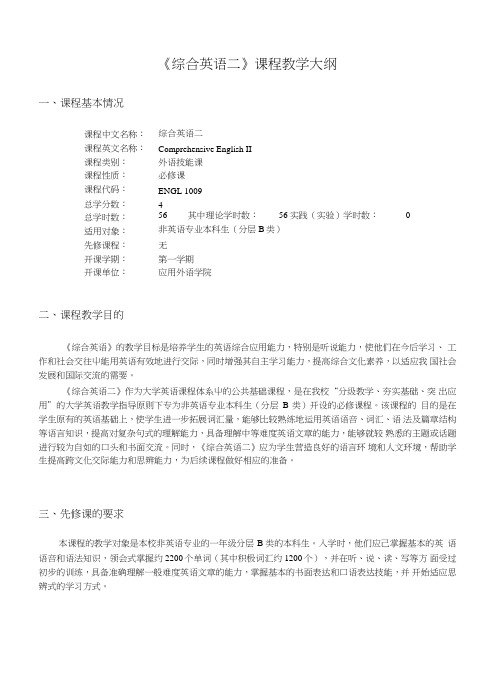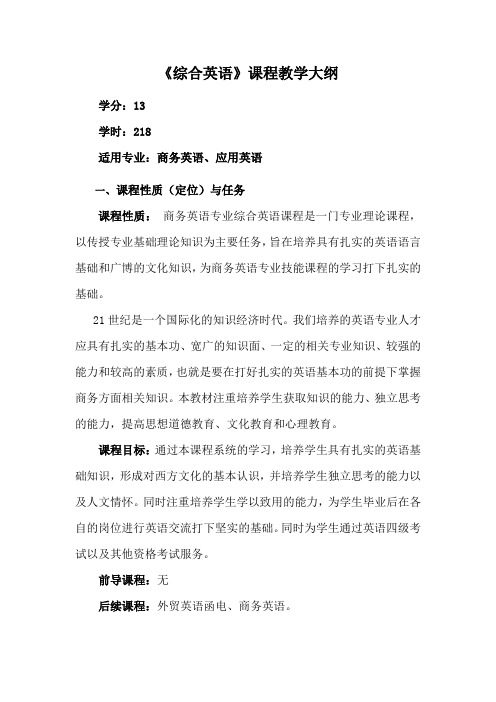《综合英语》课程教学大纲
- 格式:doc
- 大小:111.00 KB
- 文档页数:7

《综合英语二》课程教学大纲一、课程基本情况课程中文名称:综合英语二课程英文名称:Comprehensive English II课程类别:外语技能课课程性质:必修课课程代码:ENGL 1009总学分数: 4总学时数:56 其中理论学时数:56 实践(实验)学时数:0适用对象:非英语专业本科生(分层B类)先修课程:无开课学期:第一学期开课单位:应用外语学院二、课程教学目的《综合英语》的教学目标是培养学生的英语综合应用能力,特别是听说能力,使他们在今后学习、工作和社会交往屮能用英语有效地进行交际,同时增强其自主学习能力,提高综合文化素养,以适应我国社会发展和国际交流的需要。
《综合英语二》作为大学英语课程体系屮的公共基础课程,是在我校“分级教学、夯实基础、突出应用”的大学英语教学指导原则下专为非英语专业本科生(分层B类)开设的必修课程。
该课程的目的是在学生原有的英语基础上,使学生进一步拓展词汇量,能够比较熟练地运用英语语咅、词汇、语法及篇章结构等语言知识,提高对复杂句式的理解能力,具备理解中等难度英语文章的能力,能够就较熟悉的主题或话题进行较为自如的口头和书面交流。
同时,《综合英语二》应为学生营造良好的语言环境和人文环境,帮助学生提高跨文化交际能力和思辨能力,为后续课程做好相应的准备。
三、先修课的要求本课程的教学对象是本校非英语专业的一年级分层B类的本科生。
入学时,他们应己掌握基本的英语语咅和语法知识,领会式掌握约2200个单词(其中积极词汇约1200个),并在听、说、读、写等方面受过初步的训练,具备准确理解一般难度英语文章的能力,掌握基本的书面表达和口语表达技能,并开始适应思辨式的学习方式。
、课程教学内容、要求及重点、难点注:每学期根据教学实际从以下十单元内容中选取六个单元展开教学。
第一章Introduction to the course(一)主要内容Introduction to teaching plan, course requirements etc.A discussion on college education and college English learning・(二)教学要求1.Introduce the teaching plan, course requirements, etc.2.Talk about the purpose of college education and English learning(三)重点和难点k Misunderstandings about college education2.Tips for successful college English study第二章Unit 1(一)主要内容Section A: Learning a Foreign LanguageSection B: Keys to Successful Online Learning(二)教学要求1.Words and expression: to grasp the key words and expressions;2.Listening: to listen for the main idea and important details;3.Speaking: to talk about English learning experience;4.Reading: to find out the meaning of unfamiliar words through contextual clues;5.Writing: to develop a paragraph of cause and effect.(三)重点和难点1.Get the main idea of the passage and analyze the text structure2.Develop a cause-and-effect paragraph第三章Unit 2(一)主要内容Section A: Deep ConcernSection B: Is There a Generation Gap(二)教学要求1.Words and expression: to grasp the key words and expressions;2.Listening: to listen for the main idea and important details;3.Speaking: to talk about generation gap;4.Reading: to distinguish between facts and opinions;5.Writing: to develop a paragraph using sequeneed order and time markers.(三)重点和难点1.Talk about the possible reasons for and solutions to generation gap2.Develop a paragraph with sequenced order of events第四章Unit 3(一)主要内容Section A: A Good Heart to Lean OnSection B: The Right Son at the Right Time(二)教学要求1 ・ Words and expression: to grasp the key words and expressions;2.Listening: to listen for the main idea and important details;3・ Speaking: to talk about views on marriage across nations;4.Reading: to find out key ideas in sentences;5.Writing: to develop a paragraph of general point supported by examples. (三)重点和难点1.Find out key ideas in sentences2.Develop a paragraph of general point supported by examples.第五章Unit 4(一)主要内容Section A: How to Make a Good impressionSection B: Body Language(二)教学要求1.Words and expressions: to grasp the key words and expressions;2.Grammar: to practice the structures of “V・ing" and u so...(that)^;3.Listening: to listen for the main idea and important details;4.Speaking: to talk about tips to make a good impression;5.Reading: to identify general statement and examples in paragraphs;6・ Writing: to develop a paragraph of a statement supported by a list of examples. (三)重点和难点1.Understand the connotation of each tip to make a good impression;2.Find out the main idea of each paragraph in Section B;3.Correctly use V-ing structure;4.Write a paragraph supported by a list of examples.第六章Unit 5(一)主要内容Section A: A battle against AIDSSection B: The Last Dive at the Olympics(二)教学要求1・ Words and expression: to grasp the key words and expressions;2.Listening: to listen for the main idea and important details;3・ Speaking: to talk about the transmission and prevention of AIDS;4.Reading: to identify general statement and details in paragraphs;5.Writing: to develop a problem-solution paragraph by writing a statement and supporting it with details. (三)重点和难点1 • Talk about the transmission and prevention of AIDS2. Develop a problem-solution paragraph第七章Unit 6(一)主要内容Section A: The TrashmanSection B: The Company Man(三)教学要求1 • Words and expression: to grasp the key words and expressions;2.Listening: to listen for the main idea and important details;3.Speaking: to talk about prejudice in jobs;4.Reading: to understand idiomatic expressions;5.Writing: to develop a paragraph of a statement supported by a list of examples.(三)重点和难点1 ・ Identify general statement and examples2. Talk about prejudice in jobs第八章Unit 7(—)主要内容Section A: Face-to-Face with GunsSection B: Should I Have a Gun?(二)教学要求1.Words and expression: to grasp the key words and expressions;2.Listening: to listen for the main idea and important details;3.Speaking: to talk about violence in the society and gun control;4.Reading: to learn to read between the lines;5.Writing: to write a paragraph of sequential actions;(三)重点和难点1 ・ Study the language points;2. Learn to talk about social problems;3・ Learn how to use new words and phrases in new contexts;4・ Learn to write a paragraph of sequential actions.第九章Unit 8(一)主要内容Section A: Birth of bright ideasSection B: Ways of increasing creativity(二)教学要求1.Words and expression: to grasp the key words and expressions;2.Listening: to listen for the main idea and important details;3.Speaking: to talk about the students9 creative ideas;4.Reading: to scan and predict the content of a passage;5.Writing: to develop a paragraph of contrast・(三)重点和难点1.Discuss how one can become more creative2.Scan and predict the content of a passage第十章Unit 9(一)主要内容Section A: College Success Made EasySection B: A Major Question of Majors(二)教学要求1.Words and expression: to grasp the key words and expressions;2.Listening: to listen for the main idea and important details;3.Speaking: to talk about the standard to judge a student;4.Reading: to learn different ways of previewing a passage;5.Writing: to develop a paragraph of a topic supported by details・(三)重点和难点1.Discuss how to judge a student in an appropriate way2.Develop a paragraph of a topic supported by details第--一章Unit 10(一)主要内容Section A: Being Honest and OpenSection B: Website Resources: The Best Aid for Cheating?(二)教学要求1.Words and expression: to grasp the key words and expressions;2・ Listening: to listen for the main idea and important details;3.Speaking: to talk about the importance of establishing and maintaining moral standards4.Reading: to understand idiomatic expressions;5.Writing: To develop a paragraph of a general principle supported by details.(三)重点和难点1.Discuss the importance of establishing and maintaining moral standards2.Develop a paragraph of a topic supported by details五、课程教学方法与手段1、传统教学与多媒体授课相结合,釆用课堂面授方式进行,充分利用现代教育技术,正确处理好多种媒体教材之I'可的关系。

综合英语教学大纲编写综合英语教学大纲I. 引言教学大纲是指为了实现教学目标,规划和组织教学活动所使用的一种指导性文件。
在综合英语教学中,教学大纲起着指导和规范教学内容、教学方法以及评估标准的作用。
本文将分为四个主要部分,分别是:教学目标、教学内容、教学方法和评估标准。
II. 教学目标综合英语教学的目标是培养学生的听、说、读、写四项英语综合运用能力。
具体目标包括:1. 提高学生的听力理解能力,包括听懂日常生活和学习中的简短对话、广播或录音材料,并能从中获取所需信息。
2. 提高学生的口语表达能力,包括能流利、准确地用英语进行交流,并就一定话题发表自己的观点。
3. 提高学生的阅读理解能力,包括能读懂简单的英语文章或报道,并从中获取所需信息。
4. 提高学生的写作能力,包括能准确地表达个人观点、组织文字,并在写作中正确运用语法、用词准确。
III. 教学内容教学内容应充分体现听、说、读、写四项技能的综合运用,并根据学生的实际需求和能力进行选择和安排。
教学内容包括以下几个方面:1. 听力:包括日常对话、新闻广播、电影或录音材料的听力训练。
通过听力练习,提高学生的听力理解能力,培养他们获取信息和解决问题的能力。
2. 口语:以日常交流为主题,包括情景对话、小组讨论和演讲等。
通过口语练习,提高学生的口语表达能力,培养他们流利、准确地用英语进行交流的能力。
3. 阅读:包括基础课文、新闻报道、短文等。
通过阅读训练,提高学生的阅读理解能力,培养他们获取信息和分析问题的能力。
4. 写作:包括日记、作文等。
通过写作训练,提高学生的写作能力,培养他们准确表达个人观点,正确运用语法和词汇的能力。
IV. 教学方法为了实现教学目标,教师应采用多种教学方法,激发学生的学习兴趣并提高学习效果。
常用的教学方法包括:1. 情景引入法:通过创设真实的情景,帮助学生理解和运用英语表达。
2. 合作学习法:鼓励学生进行小组活动,促进彼此间的合作、交流和互助。

《综合英语 2》课程教学大纲课程名称:综合英语 2/Comprehensive English 2课程类型:专业基础课课程性质:必修/学位课适用专业:英语专业(商务方向)、对外汉语专业学时数:96 其中,实验/上机学时:0学分数:6 考核方式:闭卷笔试预修课程:高中英语教学参考书:杨立民编.现代大学英语 2.外语教学与研究出版社.出版时间:2011杨立民编.现代大学英语 2 教师用书.外语教学与研究出版社.出版时间:2011开课单位:外国语学院英语系课程简介:《综合英语》课程是为我院英语系学生在基础阶段(一、二年级)所开设的一门最为重要的必修课程,在专业英语一、二年级共开设 4 个学期,使用普通高等教育“十一五”国家级规划教材,即:《现代大学英语》(第 1-4 册)。
该课程的教学对象为本科一二年级学生。
总学时 360,总学分 22.5。
该课程是一门综合技能课,主要通过语言基础训练与篇章讲解分析以及大量的交际实践练习,使学生逐步提高语篇阅读理解能力,了解英语各种文体的表达方式和特点,扩大词汇量和熟悉英语常用句型,具备基本的口头交际能力与笔头表达能力。
通过本门课程帮助学生打好坚实的语言知识基础,培养和提高学生综合运用英语的能力,促进学生学习策略的形成、发展和完善。
本门课程对学生知识、能力和素质的培养目标:1.进一步扩大学生词汇量, 加深学生对各项语法知识的理解2.大量阅读,培养学生阅读速度及技巧,并提高学生对文章的理解鉴赏能力3.通过课内外实践培养学生的语言输出能力Unit One Another School Year---What For? (6 学时)教学目的与要求:1.Dictation2.Grammar3.Oral Practice4.Vocabulary5.Reading Skill6.Writing教学重点与难点:1.Grammar Usagenguage Communication3.Vocabulary Extension教学内容:Part One Background information & Warm-up activities (1 学时) Part Two Text Analysis, grammar and vocabulary (3 学时) Part Three Oral practice and exercises (2 学时)Unit Two Say Yes (6 学时)教学目的与要求:1.Dictation2.Grammar3.Oral Practice4.Vocabulary5.Reading Skill6.Writing教学重点与难点:1.Grammar Usagenguage Communication3.Vocabulary Extension教学内容:Part One Background information & Warm-up activities (1 学时) Part Two Text Analysis, grammar and vocabulary (3 学时) Part Three Oral practice and exercises (2 学时)Unit Three The Rite of Spring (6 学时)教学目的与要求:1.Dictation2.Grammar3.Oral Practice4.Vocabulary5.Reading Skill6.Writing教学重点与难点:1.Grammar Usagenguage Communication3.Vocabulary Extension教学内容:Part One Background information & Warm-up activities (1 学时) Part Two Text Analysis, grammar and vocabulary (3 学时) Part Three Oral practice and exercises (2 学时)Unit Four The Man in The Water (6 学时) 教学目的与要求:1.Dictation2.Grammar3.Oral Practice4.Vocabulary5.Reading Skill6.Writing教学重点与难点:1.Grammar Usagenguage Communication3.Vocabulary Extension教学内容:Part One Background information & Warm-up activities (1 学时) Part Two Text Analysis, grammar and vocabulary (3 学时) Part Three Oral practice and exercises (2 学时)Unit Five Quick Fix Society (6 学时)教学目的与要求:1.Dictation2.Grammar3.Oral Practice4.Vocabulary5.Reading Skill6.Writing教学重点与难点:1.Grammar Usagenguage Communication3.Vocabulary Extension教学内容:Part One Background information & Warm-up activities (1 学时) Part Two Text Analysis, grammar and vocabulary (3 学时) Part Three Oral practice and exercises (2 学时)Unit Six Wisdom of Bearwood (6 学时)教学目的与要求:1.Dictation2.Grammar3.Oral Practice4.Vocabulary5.Reading Skill6.Writing教学重点与难点:1.Grammar Usagenguage Communication3.Vocabulary Extension教学内容:Part One Background information & Warm-up activities (1 学时) Part Two Text Analysis, grammar and vocabulary (3 学时) Part Three Oral practice and exercises (2 学时)Unit Seven Inter-Lesson (I)(6 学时)教学目的和要求1.Vocabulary2.Grammar3.Reading4.Translation5.Writing教学重点和难点1.Grammar Usagenguage Communication3.Vocabulary Extension教学内容Part One Word-Formation (1 学时)Part Two Cloze (1 学时)Part Three Translation (1 学时)Part Four Proofreading (1 学时)Part Five Reading Comprehension (2 学时)Unit Eight The Man In Asbestos (6 学时)教学目的与要求:2.Grammar3.Oral Practice4.Vocabulary5.Reading Skill6.Writing教学重点与难点:1.Grammar Usagenguage Communication3.Vocabulary Extension教学内容:Part One Background information & Warm-up activities (1 学时)Part Two Text Analysis, grammar and vocabulary (3 学时)Part Three Oral practice and exercises (2 学时)Unit Nine Confessions of a Miseducated Man (6 学时) 教学目的与要求:1.Dictation2.Grammar3.Oral Practice4.Vocabulary5.Reading Skill6.Writing教学重点与难点:1.Grammar Usagenguage Communication3.Vocabulary Extension教学内容:Part One Background information & Warm-up activities (1 学时)Part Two Text Analysis, grammar and vocabulary (3 学时)Part Three Oral practice and exercises (2 学时)Unit Ten Pompeii (6 学时)教学目的与要求:1.Dictation2.Grammar3.Oral Practice5.Reading Skill6.Writing教学重点与难点:1.Grammar Usagenguage Communication3.Vocabulary Extension教学内容:Part One Background information & Warm-up activities (1 学时)Part Two Text Analysis, grammar and vocabulary (3 学时)Part Three Oral practice and exercises (2 学时)Unit Eleven Button, Button (6 学时)教学目的与要求:1.Dictation2.Grammar3.Oral Practice4.Vocabulary5.Reading Skill6.Writing教学重点与难点:1.Grammar Usagenguage Communication3.Vocabulary Extension教学内容:Part One Background information & Warm-up activities (1 学时)Part Two Text Analysis, grammar and vocabulary (3 学时)Part Three Oral practice and exercises (2 学时)Unit Twelve A Fundamental Technique in Handling People(6 学时) 教学目的与要求:1.Dictation2.Grammar3.Oral Practice4.Vocabulary5.Reading Skill6.Writing教学重点与难点:1.Grammar Usagenguage Communication3.Vocabulary Extension教学内容:Part One Background information & Warm-up activities (1 学时) Part Two Text Analysis, grammar and vocabulary (3 学时) Part Three Oral practice and exercises (2 学时)Unit Thirteen Mr. Imagination (6 学时)教学目的与要求:1.Dictation2.Grammar3.Oral Practice4.Vocabulary5.Reading Skill6.Writing教学重点与难点:1.Grammar Usagenguage Communication3.Vocabulary Extension教学内容:Part One Background information & Warm-up activities (1 学时) Part Two Text Analysis, grammar and vocabulary (3 学时) Part Three Oral practice and exercises (2 学时)Unit Fourteen Inter-Lesson (II)(6 学时)教学目的和要求1.Vocabulary2.Grammar3.Reading4.Translation5.Writing教学重点和难点1.Grammar Usagenguage Communication3.Vocabulary Extension教学内容Part One Word-Formation (1 学时)Part Two Cloze (1 学时)Part Three Translation (1 学时)Part Four Proofreading (1 学时)Part Five Reading Comprehension (2 学时)Unit Fifteen Obama’s Victory Speech (6 学时) 教学目的与要求:1.Dictation2.Grammar3.Oral Practice4.Vocabulary5.Reading Skill6.Writing教学重点与难点:1.Grammar Usagenguage Communication3.Vocabulary Extension教学内容:Part One Background information & Warm-up activities (1 学时) Part Two Text Analysis, grammar and vocabulary (3 学时) Part Three Oral practice and exercises (2 学时)Unit Sixteen the oyster and the pearl (6 学时) 教学目的与要求:1.Dictation2.Grammar3.Oral Practice4.Vocabulary5.Reading Skill6.Writing教学重点与难点:1.Grammar Usagenguage Communication3.Vocabulary Extension教学内容:Part One Background information & Warm-up activities (1 学时) Part Two Text Analysis, grammar and vocabulary (3 学时) Part Three Oral practice and exercises (2 学时)。

《综合英语》教学大纲一、总纲《综合英语》是高等院校英语专业的一门专业基础必修课。
它主要从听、说、读、写、译等方面,通过循序渐进的方式,使学生逐步掌握系统的语言基础知识,包括语言体系知识、话语知识和“常用语”知识,为他们提高语言交际能力打下坚实的基础。
同时还培养学生以下几个方面的能力:1、学习者的学习策略能力;2、语言尝试能力;3、语言思维能力;4、语言教师的职业能力。
此外,还兼顾文化知识的学习。
教学目标:注重培养学生的语言基本功,使听、说、读、写、译的能力打下扎实的基础;传授英语基础知识,对学生进行全面的、严格的基本技能训练,培养学生实际运用语言的能力、良好的学风和正确的学习方法,为进入高年级打下扎实的专业基础。
学时分配:《综合英语》(Integrated Skills of English)课程须完成268学时。
课程安排在第1、2、3、4学期,每周4学时。
使用教材:《综合英语教程》1,2册邹为诚等编著高等教育出版社1998年版。
主要参考书目:(1)《新编英语教程》-1,李观仪等编著;上海外语教育出版社;1998版。
(2)《新编英语教程》-2, A New English Course 李观仪主编;上海外语教育出版社;1998年版(3)《朗文英语语法》Longman English Grammar L.G.亚历山大主编外语教学与研究出版社(4)《语言技能训练指导TEM4》邹申主编上海外语教育出版社(5)《新编英语教程》-3,李观仪等编著,上海外语教育出版社,1999年8月第二版(6)《新编英语教程》-4,李观仪等编著,上海外语教育出版社1998年版考核方式:闭卷考试。
二、主要内容及教学大纲要求绪论(1学时)主要内容:课程内容注重各项语言技能的全面发展,突出语言交际能力的培养。
使学生在听、说、读、写、译等各项技能方面得到全面发展。
加强学生思维能力和创新能力的培养。
要求在教学中要有意识地训练学生分析与综合、抽象与概括、多角度分析问题等多种思维能力以及发现问题、解决难题等创新能力。

《综合英语》课程教学大纲学分:13学时:218适用专业:商务英语、应用英语一、课程性质(定位)与任务课程性质:商务英语专业综合英语课程是一门专业理论课程,以传授专业基础理论知识为主要任务,旨在培养具有扎实的英语语言基础和广博的文化知识,为商务英语专业技能课程的学习打下扎实的基础。
21世纪是一个国际化的知识经济时代。
我们培养的英语专业人才应具有扎实的基本功、宽广的知识面、一定的相关专业知识、较强的能力和较高的素质,也就是要在打好扎实的英语基本功的前提下掌握商务方面相关知识。
本教材注重培养学生获取知识的能力、独立思考的能力,提高思想道德教育、文化教育和心理教育。
课程目标:通过本课程系统的学习,培养学生具有扎实的英语基础知识,形成对西方文化的基本认识,并培养学生独立思考的能力以及人文情怀。
同时注重培养学生学以致用的能力,为学生毕业后在各自的岗位进行英语交流打下坚实的基础。
同时为学生通过英语四级考试以及其他资格考试服务。
前导课程:无后续课程:外贸英语函电、商务英语。
二、课程目标知识目标:(一)系统地传播学生所必须掌握的英语基础知识及语言点,训练基本的语言技能及运用能力,为今后学生的英语实际运用打下良好的基础。
(二)培养学生分析和解决问题的能力,培养良好的听、说、写的能力。
(三)在该阶段掌握词汇4000左右,并能进行系统的语法,词汇的辨析。
(四)能独立阅读,听懂各种体裁文章,能写出相当四级水平的作文。
技能目标:培养学生学以致用的能力以及英语交流、表达的能力,具有辩证思维,客观看待中西方文化差异,并在此基础上进行有效地跨文化交流。
素质目标:要求学生具有独立思考的能力,具备人文关怀,对文化差异持包容的态度,客观评价中西文化,能够做到取长补短,最终形成自己对中西方文化的科学认识。
培养学生团队合作、积极主动、谦虚谨慎等职业道德,以及准确、流利地表达自身的观点,尊重他人的观点等交流的能力。
三、教学内容及具体要求本课程涉及语言、文化、习俗、伦理、信息、科学、社会焦点等方面,注重选材的趣味性、信息性、实用性和时代性,题材广泛,体裁多样。

《综合英语》课程教学大纲Comprehensive English总学时数:__256_学分数: _16__ 其中:实践学时:____适用专业:英语〔商务〕执笔者: _黄燕丽〔讲师/硕士〕编写日期:2013.03一、课程的性质、目的和任务《综合英语》是英语〔商务〕专业的学科根底课程。
它是一门培养学生听、说、读、写、译等综合技能的课程。
本课程教学目的和任务在于传授英语根底知识,对学生进展全面的、严格的根本语言技能训练,培养学生实际运用语言的能力,培养学生正确的学习方法和良好的学习作风,培养学生逻辑思维能力和独立工作能力,丰富学生的社会文化知识,增强学生对文化差异的敏感性,为学生学习高年级专业课程打下扎实的根底。
二、课程教学的根本要求对英语专业本科学生而言,综合英语是一门最主要的课程。
它是英语学习的核心,通过该课程的学习,学生应了解各类体裁的文章与英美等国家的文化,掌握全面的英语应用技能,具备综合运用语言知识的交际能力。
教学的具体要求如下:1.语音: 能按照音标读出单词,发音正确;能朗读句子、课文与相应的课外短文,语音语调正确。
2.词汇: 领会式掌握5000词汇与词组。
对其中4000个单词与其常用词组要求能够熟练掌握,并用于英语语言交际实践中。
3.语法;掌握根本语法规那么,能解决阅读中较复杂的语法难题。
4.听说:能够就某一话题开展全面的具有创造性和话语连贯性的语言活动,并将语言知识、交际技能和教学技巧融为一体。
5.阅读:掌握根本阅读技能,能借助词典顺利阅读并正确理解难度于课文容相当的各种题材的文章,阅读速度达到每分钟60个词。
6.翻译:能将与课文难易程度相当的文章译成汉语,理解正确、完整、明了。
7.写作:掌握不同体裁文章(记叙文,议论文,应用文等)的写作格式, 做到语确,表达清晰,论点明确,有较强的思想性。
三、课程教学容、重点和难点教学容:本课程依据所选教材的容并结合实际情况,因材施教,帮助学生掌握所选教材中涉与的词汇、词组、课文与语法知识,同时进展听说、阅读、写作训练,使学生全面掌握英语的各项根本技能。
《综合英语》课程教学大纲
一.课程名称:综合英语
二.课程类别:专业必修课
三.教学时数:
综合英语课课程开设两年,共四个学期。
每周6学时,共计408学时。
四.学分:总计24学分。
五.开课时间:第1-4学期
六.教学对象:英语专业本科1-2年级学生
七.教学目的:
综合英语课课程是英语(法律经贸方向)专业一、二年级主要学科基础课之一,其教学目的为通过系统地讲授英语基础知识,综合训练基本语言技能,提供英语学习方法指导,培养学生运用英语进行交际的能力,以达到全面发展听、说、读、写四项语言能力。
同时通过综合英语课程的学习,为学生打下语言能力和交际能力两方面的坚实基础。
所谓语言能力就是指能够正确、自然而灵活地掌握语言本身,而交际能力则是指能在某些场合适当地并随机应变地使用语言的能力。
本课程要求学生在两年内累计掌握4600-6000常用词的主要用法,熟练掌握和灵活运用所学教材中的句子结构和语法项目,能运用英语词典和有关工具书阅读有一定难度的原版文献,具有对教材内容进行分析、批判、评论的能力,并具有较规范的口头表达和扎实的书面表达功底。
八.课程内容:
学生在2年内完成1-4册《现代大学英语(精读)》课程的学习,全面发展四项语言能力,但在不同学习阶段侧重点不同。
第1、2册侧重盘活中学所学内容,第3、4册侧重全面完成基础阶段的训练。
教学的重点放在对学生语言技能、尤其是口笔头复用能力的综合训练上,以使学生能够正确、自然而流畅地运用本课程所教授的语言知识,并能灵活准确地应用到适当场合中去。
九.教学时间安排:
综合英语课课程教学分为两个阶段:第一学年为第一阶段,着重于培养学生养成良好的学习习惯和独立工作能力,大力盘活中学所学,消化并提升中学所学知识,使之成为语言交际的实际能力,并积极介绍各种新的语言现象,为完成下一年任务打下基础;第二学年为第二阶段,着重于学生的各项技能的全面训练,指导学生进行广泛阅读,口语应由第一年的问答应对及简单复述过渡到较长的叙述、描写、以及初步的分析和辩论的能力的培养上,全面提高学生独立工作能力,养成使用基本工具书以及对教材内容进行分析、批判、
十.教材与参考书
采用外语教学与研究出版社出版、杨立民主编的《现代大学英语教程(精读)》1-4册,该教材为普通高等教育“十五”国家级规划教材及北京市高等教育精品教材立项项目。
分4期学完。
本课程主要参考书目:
Merriam-Webster’s Collegiate Encyclopedia, Springfield, Mass: Merriam-Webster,Inc.,2000 The New American Desk Encyclopedia, Concord Reference Books, Inc. 1984.
Encyclopedia Britannica
Encyclopedia Americana
十一.课程考核:
本课程考核成绩由平时成绩20%(包括作业、测验、课堂讨论等)和期末成绩80%组成。
考试方式为闭卷。
本大纲制定人:曾早垒。